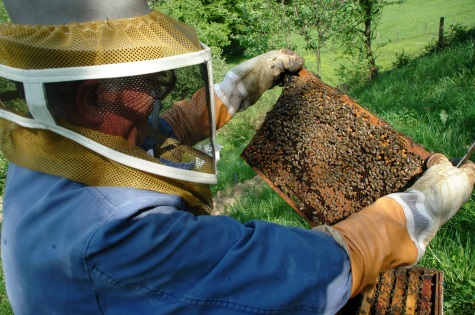07
Jan
EPA Data Confirms Honey Bee Exposure to Hazardous Pesticides
(Beyond Pesticides, January 7, 2016) A long-awaited U.S. Environmental Protection Agency (EPA) preliminary honey bee risk assessment, released yesterday, for one of the most widely used pesticides linked to severely declining honey bee populations confirms harmful residues of the chemical in crops where the pollinators forage, including citrus and other crops. While EPA finds the insecticide imidacloprid, a neonicotinoid or neonic pesticide, at various levels in crops, the assessment confirms bees’ widespread and sustained exposure to the highly toxic and persistent chemical through poisoned pollen and nectar. EPA’s assessment failed to address risks posed to wild bees and widespread exposure through soil and water. [See docket with EPA documents, for which EPA has set a 60-public comment period.]
 “We cannot incorporate highly toxic and persistent chemicals into virtually all agricultural crops and ornamental plants without detrimental impacts on large populations of bees, butterflies, and birds and other organisms important to a healthy ecosystem on which life depends,” said Jay Feldman, executive director of Beyond Pesticides, a science and advocacy group based in Washington, DC. “Even low level exposures to bees over vast acreage represent an unsustainable threat,” he continued.
“We cannot incorporate highly toxic and persistent chemicals into virtually all agricultural crops and ornamental plants without detrimental impacts on large populations of bees, butterflies, and birds and other organisms important to a healthy ecosystem on which life depends,” said Jay Feldman, executive director of Beyond Pesticides, a science and advocacy group based in Washington, DC. “Even low level exposures to bees over vast acreage represent an unsustainable threat,” he continued.
Other toxic pesticides in the neonicotinoid class of insecticides have been linked to pollinator decline in over a hundred independent scientific studies. The class is known as systemic pesticides because they are taken up by the vascular system of the plant and then expressed through pollen, nectar, and guttation droplets, killing target and non-target organisms indiscriminately. The neonicotinoids are still under EPA review, while the European Union, numerous retailers, and local cities and towns have adopted policies that stop their use. Beyond Pesticides points to a thriving organic industry as the alternative to the neonicotinoids.
The preliminary honey bee assessment confirms that imidacloprid is highly toxic to honey bees, with exposure resulting in reduced numbers of worker bees, less foraging, and delayed development. EPA finds that in agriculture, bees are at risk both in fields and adjacent to fields where imidacloprid is sprayed, especially on citrus and cotton. EPA’s review of available data finds that other bees, like bumble bees, are also at risk. Imidacloprid exposures impact reproduction and colony health.
Nichelle Harriott, Beyond Pesticides’ science and regulatory director, said: “Today’s imidacloprid honey bee assessment confirms much of the existing scientific evidence showing imidacloprid’s toxicity to bees. However, the agency still falls short in fully assessing broader risks to wild bees and other non-target organisms. Time is of the essence and bees and other pollinators cannot wait for EPA to slowly complete these reviews. The agency must take action and suspend imidacloprid and other neonicotinoids to protect pollinators.”
Imidacloprid, like the other chemicals in its class, is not only highly toxic to bees, but a growing number of studies find that even at low levels neonicotinoids impair foraging ability, navigation, learning behavior, and suppress the immune system, making bees more susceptible to pathogens and disease. Recent studies already find that imidacloprid reduces foraging behavior in bumble bees, reduces colony growth, and increases neuronal dysfunction. Long-term sublethal exposures are also linked to chronic behavioral impairment.
According to government statistics, 42 percent of managed honey bees across the country were lost over 2014/2015, representing the second highest loss to date. There have been a number of EPA actions attempting to reduce honey bee exposure to bee-toxic pesticides, including a moratorium on new neonicotinoid uses and products, as well as a proposal to temporarily prohibit foliar applications of pesticides acutely toxic to honey bees during bloom. Due to the systemic nature of many of these pesticides, scientists find that these measures fall short of providing long-term, comprehensive protections for pollinators.
Imidacloprid is one of the oldest neonicotinoids in use and is used in a variety of settings, including agriculture, numerous home and garden products, as well as pet products. The agency notes that the registration review of other neonicotinoids, like clothianidin and thiamethoxam, should be available sometime in December 2016.
See more information on the serious decline of honey and other pollinators at www.beeprotective.org.
Download the press release here.
###
Contact:
Nichelle Harriott, 202-543-5450
[email protected]
Jay Feldman, 202-255-4296
[email protected]
www.beyondpesticides.org










